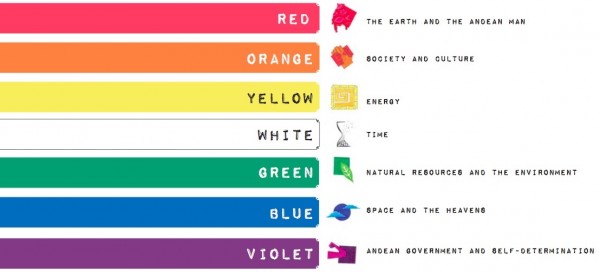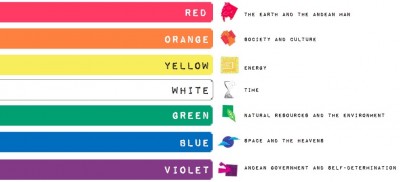The Flag of the People

28 Oct, 2015 | Rafael Bertoli-Mitchell
As I sat in the teléferico for the first time, slowly rolling up the valley to El Alto, a friend pointed out what we thought to be a multicoloured LGBTQ flag. Even the Bolivians that I spoke to were unaware of the banner’s origins. Finding out its exact meaning would require a look back into history.
The Wiphala is a symbol of the Aymara people and emerged during the days of the Incan Empire, where it was a processional banner. It consists of 49 small squares in a seven-by-seven grid. The seven colours in the grid are representations of the rainbow, a theme that occurs repeatedly in Quechua and Aymara art and design. Arranged diagonally, each row and column is made of the seven distinct colours.
Four different Wiphala arrangements were used during the Incan Empire, representing the four Incan provinces. The colour of the longest diagonal line indicates which region the Wiphala represents:
White: Collasuyu (the southeastern province, representing the territories of Peru, Bolivia, and parts of Chile and Argentina)
Yellow: Cuntisuyu (the southwestern province, representing southwestern Peru)
Red: Chinchansuyu (the northwestern province, covering Ecuador, central and northern Peru, and southwestern Colombia)
Green: Antisuyu (the eastern province, made up of eastern Peru and part of Bolivia)
In recent years (notably the mobilisation of indigenous movements in the 1970s), the Wiphala has been adopted in neighbouring South American countries, and has become ubiquitous at pan-Andean public events and demonstrations. Bolivian President Evo Morales established the Collasuyu Wiphala as the nation's dual flag along with the previous red, yellow and green banner in the newly-ratified constitution. In this modern form, the seven colours of the Wiphala have acquired new meanings:
Red: The Earth and the Andean man
Orange: Society and culture
Yellow: Energy
White: Time
Green: Natural resources and the environment
Blue: Space and the heavens
Violet: Andean government and self-determination
For more information about the history of Bolivia and the Incan Empire, see Waltraud Q. Morales’ A Brief History of Bolivia.








